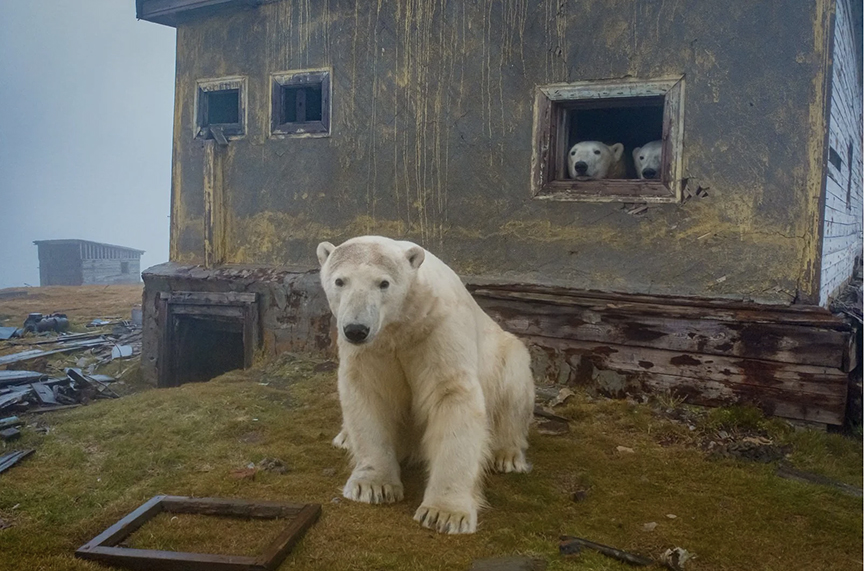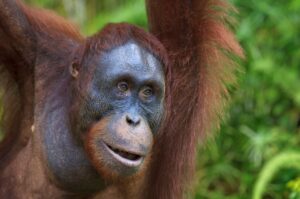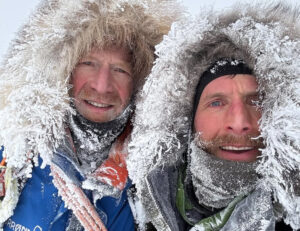In the last week, haunting images of polar bears peering out from abandoned cabins in the Russian Arctic have gone viral. ExplorersWeb spoke to Dmitry Kokh, the tech entrepreneur-turned-photographer who took the images.
The 41-year old Kokh runs a successful tech company in Moscow. The popularity of his photos has surprised even him. He has had to take a vacation from his day job, because of the endless requests to buy prints of the bears.

Enjoys the company of animals
Kokh is an introvert by nature. He seems to feel more comfortable around animals than people. He tends to spend most of his time traveling to the wildest, least accessible places.
Last August, he and a friend traveled 2,000km on a small ice-class sailing yacht to Russia’s Wrangel Island, known as a polar bear maternity ward. Kokh hoped to capture the white bears up close.
The two adventurers slowly made their way along the coast, past humpback whales, sea lions, seals, and birds, across a constantly shifting ice-and-water puzzle. They stopped in deserted bays, saw plenty of brown bears, and went scuba diving in the freezing waters of the Chukchi Sea. As you can see from his website, Kokh is also a serious underwater photographer.

Eventually, the sea ice thickened. It was early fall, the best time of year to travel up there because the ice is at its minimum, and they were not expecting this obstacle.
One day, a storm caught them in the middle of the Chukchi Sea and forced them to take refuge behind a small island named Kolyuchin. Today, Kolyuchin is entirely abandoned, but it was a thriving community when I first visited it 36 years ago as Pravda’s polar reporter.

The story of Kolyuchin Island
Kolyuchin’s name tells its history. Kulusik means a “field of sea ice” in the Chaplino Eskimo dialect, while Kuvluch’in means “round” in Chukchi. Indeed, from above, Kolyuchin looks almost round, and since ice and snow cover it for nine months a year, it is almost always white.
For millennia, Kolyuchin has been a hunting ground both for the Chukchi and the Yupik, who shared the island. Some lived all year round in a small settlement, while others migrated here in the summer to hunt walruses, seals, and polar bears, and to collect berries, mushrooms, and eggs.

Then, in 1934, at the height of Soviet colonization of the Arctic, a polar meteorological station was built on the island. This was not an easy ordeal for those assigned there. Logistics were horrible, and there was no fresh water. By then, the indigenous name of the island had become russified into Kolyuchin, which literally means “a prickly place”.
The indigenous elders who grew up on the island told me another story of Kolyuchin’s name. According to their version, Keglusin means a lonely maritime giant, or rather, a lonely adult walrus who had lost its mother too early, in infancy. It grew up to be mean and aggressive, attacking everyone.
The island was apt for such a legend, because of its humongous walrus aggregations. They gather in the thousands on the rocky beaches.
Kolyuchin abandoned
Time stopped on Kolyuchin in 1992, soon after the collapse of the Soviet Union. Because of lack of funding, the polar station, like many others in the Arctic, shut down. Today, Kolyuchin is wilderness with a few derelict buildings. Occasionally, locals come here by boat or dogsled from nearby Nutepelmen, 14km away, to hunt.

‘We noticed a movement in the window’
“There was a lot of wind, rain and fog,” said Kokh when we spoke over the phone. “As we were waiting for the weather, we noticed a movement in the window of the abandoned station. This was strange. I grabbed the binoculars, and to my amusement, I saw a polar bear in the house. And then another one, and another. We could not land, so I flew my drone.”

“One never knows what and when nature presents you with. I just know that the best gifts come when we least expect it. One has to be ready.”
And ready he was. As a tech guy, Kokh has played with drones for a long time. None of those on the market were good enough for what he wanted, so he decided to build his own. He used a regular DJI Mavic 2 and modified it with low-noise propellers, which he ordered on AliExpress from China. Kokh knew that the model’s original noisy propellers would scare the animals off.
He also developed a special tactic, similar to the one used by indigenous polar bear hunters. He approached them slowly, zigzagging and avoiding a direct advance. This worked well on Kolyuchin: The bears just took the drone for a low-flying gull and went about their business. You can see his successful approach in how relaxed the bears are in the photos.

Important not to disturb the animals
“When my photos went viral, I did not want to say too much about how I made them,” says Kokh. “But later, as most people came to believe that I simply walked with the bears, I thought that sent the wrong message. A human should not walk with the bears, for the good of both. So I decided to make it clear how exactly I produced these images.
“Drones are easy to operate, but one has to be extremely cautious not to disturb the animals, and this takes a lot of knowledge of psychology, as well as tech skills.”
Most arctic cruise ships, for example, don’t allow its passengers to fly drones, because they can’t be relied upon to have Kokh’s sensitivity or knowledge to avoid disturbing the animals.
Polar bears have become a symbol of climate change. Photographers often picture them on dwindling pieces of sea ice amid rising temperatures. The images convey a message of grief at the prospect of their disappearance.
Kokh’s photos portray the bears in a happier light. They seem to be thriving in the remnants of human civilization. It may be an illusion, because the bears live among rusted oil drums, debris, and dilapidated huts. But the overall impression gives a message of thriving life, overcoming disintegration, a mood of hope.

Why do the bears go into cabins?
This morning, I called a few biologists who have studied polar bears all their lives. None could explain why polar bears would inhabit a human house.
But Anatoly Kochnev, a polar bear specialist living in Anadyr, Chukotka, who had spent 18 seasons on Kolyuchin, had his own hypothesis.
According to Kochnev, polar bears on Kolyuchin are quite familiar with humans. They have been hunted here for centuries, and even now occasionally local residents shoot an animal or two, although it is against the law. So bears use the polar station as a refuge. Once a boat shows on the horizon, with all its familiar sounds, they retreat into the building.
Shortly before Kokh arrived in the area, a cruise ship did turn up nearby. They drove along the coast in Zodiacs, photographing the shore bears through long lenses.
Kochnev has managed to create Russia’s first database logging the conflicts between polar bears and humans. He recalls that in his first five years of work in the Arctic, he saw polar bears only twice. In those days, the bears lived on the sea ice, far from settlements. Today, polar bears are often forced into settlements because the summer sea ice has vanished.

A future truce?
But even their increasing presence near people may be workable. Kochnev points out that polar bears, unlike brown bears, are not territorial. Near Cape Schmidt, there is a Chukchi settlement named Ryrkaypiy. Every fall, dozens of polar bears gather on the beach, just two kilometres away from the village, waiting for new ice to form, as in Churchill, Manitoba.
Over the years, humans and animals have somehow learned to respect each other’s privacy. Maybe there is a way for people and bears elsewhere to become good neighbors in the Arctic.
There is a legend in Greenland, which I first heard 10 years ago in Qaanaaq. This is how it goes. In the old days, polar bears used to be people. After a while, they would go back to their homes, take off their heavy fur coats, sit down around the table, and have some tea. It was a time when humans and animals lived in harmony, and the circle of life was unbroken.
Even though most people have never heard of this legend, the hopeful, unifying message of Dmitry Kokh’s images somehow resonate within us.


Visual artist Galya Morrell has lived and traveled in the Arctic for over 30 years. Under the stage name ColdArtist, Galya explores the limits of the body and the possibilities of the mind, working in a rare genre of visual synthetic performance on the drifting sea ice. Together with Greenlandic polar explorer and actor, Ole Jorgen Hammeken, Galya has founded many cultural initiatives focused on the circumpolar regions.






